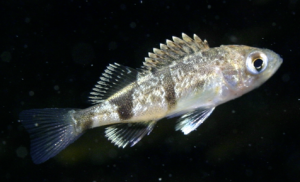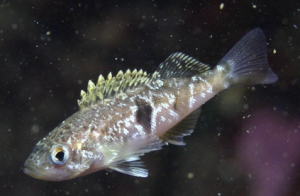
By almost any measure, the 2013 spring and early summer are showing clear signs of a record recruitment of young-of-the-year (YOY) fishes, and especially rockfishes. Recent juvenile rockfish surveys off the coast of central CA by marine ecologists at the National Marine Fisheries Service (NMFS) indicate 2013 is a blockbuster year.
“This is an extraordinary year for rockfish recruitment,” says Tom Laidig, a NMFS scientist based in Santa Cruz. An expert in juvenile rockfishes (the genus Sebastes), Laidig is excited about the prospect of not only high densities but also the variety of species showing up in 2013. “From our offshore survey data, this is the strongest recruitment year since the late 1980’s. Rockfishes are long-lived species (over 100 years for some species) and these episodic events are necessary for rebuilding the population sizes back toward historic levels.”

Copper rockfishes, which are usually among the first YOY to show up in local kelp forests, were already in Monterey Harbor by mid-April, a few weeks ahead of schedule. By mid-May, citizen scientists diving for Reef Environmental Education Foundation (REEF) in Carmel Bay as part of an annual survey of local kelp forests were astounded by the numbers and diversity of YOY fishes. Diving with the REEF surveyors was Dr. Steve Lonhart, a marine ecologist for Monterey Bay National Marine Sanctuary.
“I could not believe how many YOYs we were seeing during the dives. Usually we see lots of blue YOYs, but we were seeing high numbers of copper, bocaccio, vermilion, canary, black, and olive-yellowtail rockfish YOY.” Although biologists often focus on the commercially targeted and economically important rockfishes, Lonhart noted a number of other YOY were present. “Besides the swarm of Sebastes YOY, including some we don’t usually see like halbanded and stripetails, we also saw other YOYs, including cabezon, greenling, painted greenling, tubesnout, senorita, and striped perch. It was amazing.”

The recruitment of YOY into the kelp forests is good news for local ecosystems, and may mean an increase in adults that are targeted by recreational and commercial fishers. But that won’t happen immediately, since most of the rockfishes will take several years to reach a large size.
It remains unclear why 2013 is showing such promise, but scientists like Laidig at NMFS will continue closely monitoring recruitment and investigating the underlying mechanisms that drive these apparently chaotic patterns.